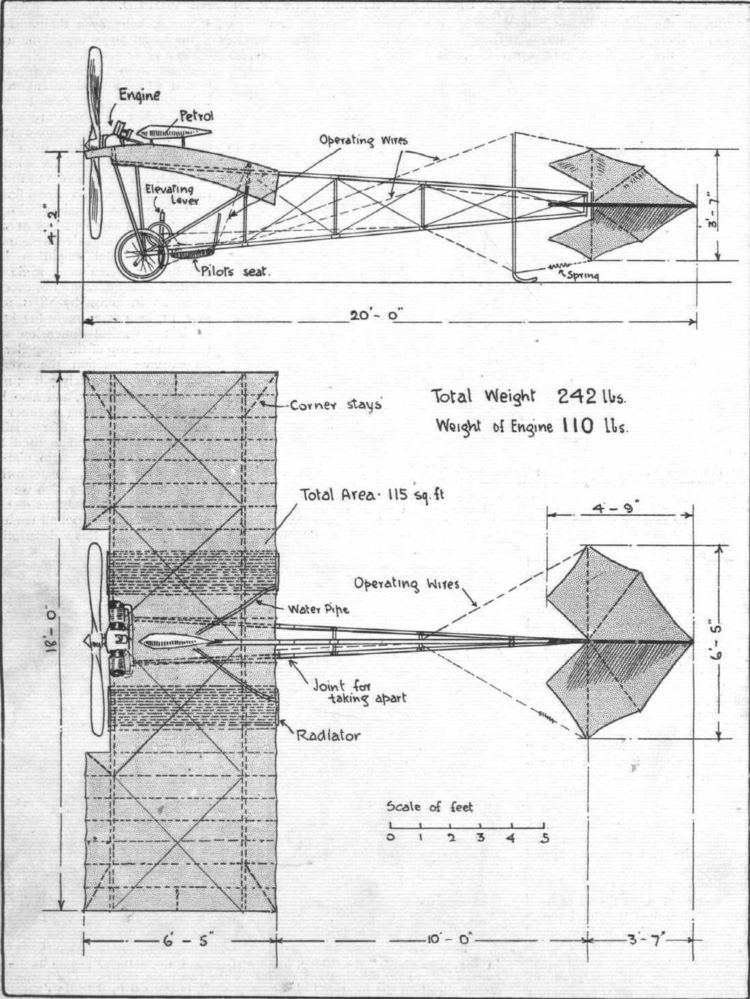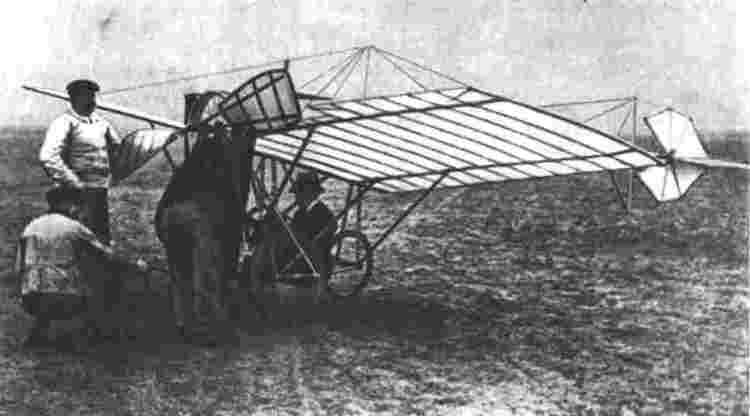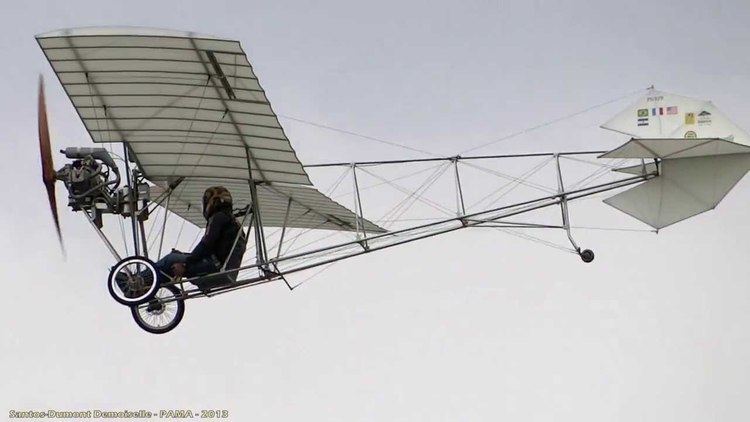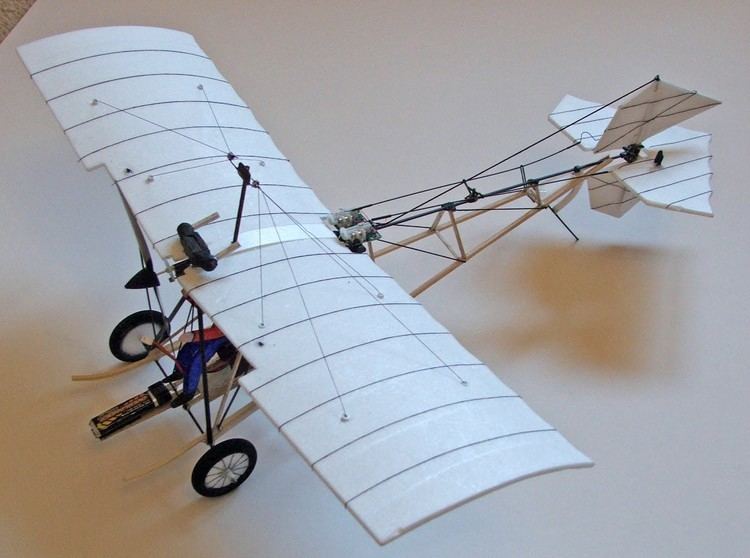Top speed 90 km/h Length 6.07 m | Wingspan 5.49 m | |
 | ||
The santos dumont demoiselle damselfly by malcolm pritchard using vapor block dsm2
The Santos-Dumont Demoiselle ("Damselfly" or "Damsel") was a series of aircraft built in France by Brazilian aviation pioneer Alberto Santos-Dumont. They were light-weight monoplanes with a wire-braced wing mounted above an open-framework fuselage built from bamboo. The pilot's seat was below the wing and between the main wheels of the undercarriage. The rear end of the boom carried a tailwheel and a cruciform tail.
Contents
- The santos dumont demoiselle damselfly by malcolm pritchard using vapor block dsm2
- The santos dumont demoiselle
- No 19
- No 20
- Specifications No 20
- References

The santos dumont demoiselle
No. 19

The first aircraft of the type was the Santos-Dumont No. 19, which was built to attempt to win the Grand Prix d'Aviation offered for a one kilometre closed-circuit flight. Powered by a 15 kW (20 hp) air-cooled Dutheil & Chalmers flat-twin engine mounted on the leading edge of the wing, it had a wingspan of 5.1 m. (16 ft 9 in), was 8 m (26 ft 3 in) long and weighed only 56 kg (123 lb) including fuel. It had a pair of hexagonal rudders below the wing on either side of the pilot, a forward mounted hexagonal elevator in front of the pilot and a cruciform tail which, like the boxkite-style canard surfaces on the earlier 14bis biplane of 1906, pivoted on a universal joint to function both as elevator and rudder mounted at the end of a substantial single boom. There was no provision for lateral control. The undercarriage consisted of a pair of wheels in front of the pilot and a third behind, supplemented by a tailskid.
Santos-Dumont made three flights on 17 November 1907 at Issy-les-Moulineaux.

Later, Santos-Dumont made a number of modifications: he repositioned the engine, placing it below the wing in front of the pilot, fitted a different propeller and deleted the forward elevator and rudders.
No. 20

Santos-Dumont's next aircraft, the Demoiselle No. 20, was first flown with an 18 kW (24-hp) Dutheil et Chalmers later replaced by a 22 kW (30 hp) Darracq-built liquid-cooled opposed twin engine of approximately 3.2 litre displacement. The fuselage consisted of three bamboo tubes forming the primary longerons, of about 5 cm (2 in) diameter, connected by oval steel tubes. For ease of transportation the bamboo tubes were divided into two sections, joined together by brass sockets. The parallel-chord wings had two spars made of ash and bamboo ribs All versions had a pair of lightweight thin-tube radiators mounted under the wing, running the entire meter chord of the wing. It used wing warping for lateral control, with control cabling that only pulled down alternately on the outer section of the rear wing spar with no "upwards" warp capability.

The Demoiselle was the last aircraft built by Santos-Dumont. He performed flights with it in Paris, and made trips to nearby places. Flights were continued at various times through 1909, including a cross-country flight with stages of about 8 km (5 mi) from St. Cyr to Buc on 13 September 1909, returning the following day, and another on 17 September 1909 of 18 km in 16 min. The aircraft was exhibited on the Clément-Bayard stand at the Paris Aéro Salon in October 1909 and it was announced that a production run of 100 aircraft was planned. However, only 50 were actually built, of which only 15 were sold, at a price of 7,500 francs for each airframe.. It was offered with a choice of 3 engines: Clement 20 hp; Wright 4-cyl 30 hp (Clement-Bayard had the license to manufacture Wright engines); and Clement-Bayard 40 hp designed by Pierre Clerget. It achieved 120 km/h.
The French pioneer aviator Roland Garros learned to fly in a Demoiselle at a flight school established by Clement Bayard, and later flew one at Belmont Park, New York in 1910. The June 1910 edition of Popular Mechanics published drawings of the Demoiselle and wrote "This machine is better than any other which has ever been built, for those who wish to reach results with the least possible expense and with a minimum of experimenting." American companies sold drawings and parts of Demoiselle for several years thereafter. Santos-Dumont was so enthusiastic about aviation that he released the drawings of Demoiselle for nothing, thinking that aviation would be the cause of a new prosperous era for mankind. An example of a Demoiselle with a Darracq engine is preserved in the Musée de l'Air et de l'Espace. A flyable replica was built by Personal Plane Services Ltd for the 1965 film Those Magnificent Men in Their Flying Machines and others have been built since then.
Specifications (No. 20)
Data from Flight, 2 October 1909, p. 604
General characteristics

Performance

